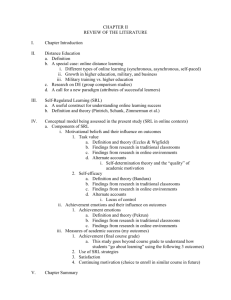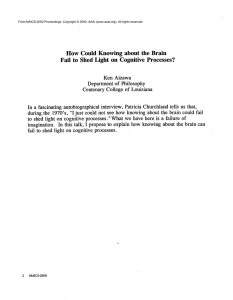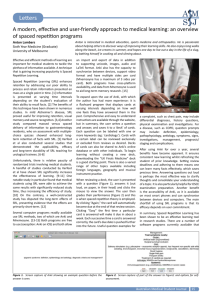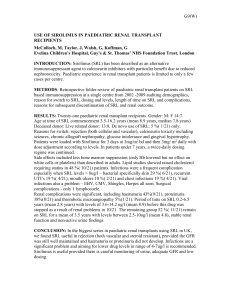Assessment of the Critical Components of a Transformative Alexei V. Samsonovich
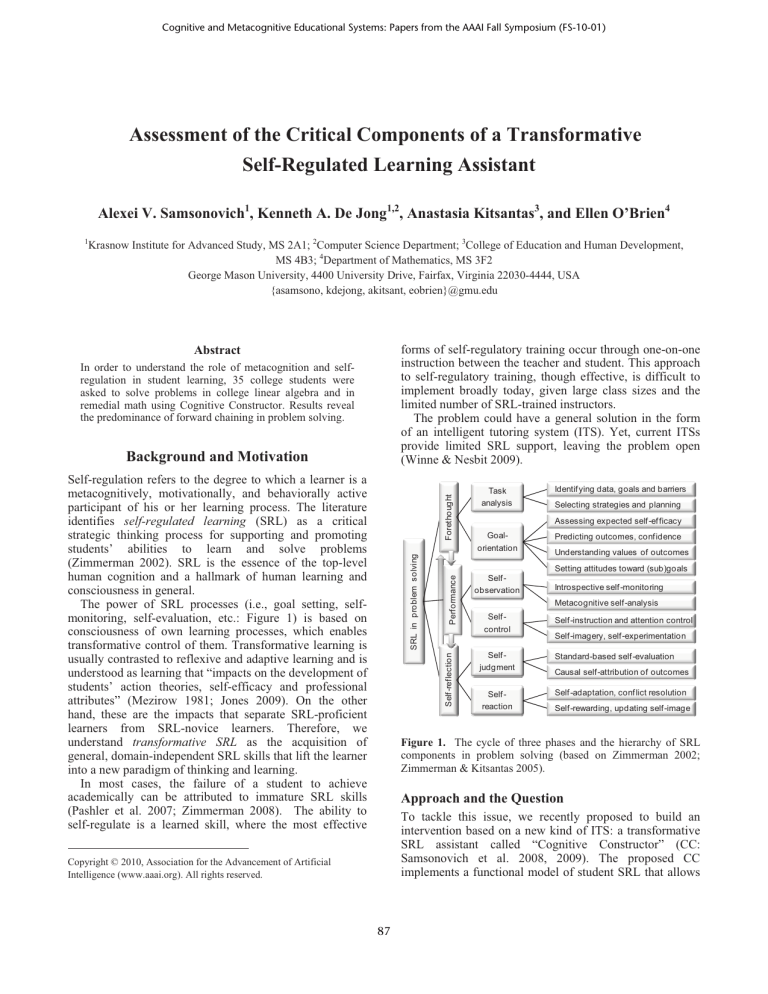
Cognitive and Metacognitive Educational Systems: Papers from the AAAI Fall Symposium (FS-10-01)
Assessment of the Critical Components of a Transformative
Self-Regulated Learning Assistant
Alexei V. Samsonovich
1
, Kenneth A. De Jong
1,2
, Anastasia Kitsantas
3
, and Ellen O’Brien
4
1
Krasnow Institute for Advanced Study, MS 2A1;
2
Computer Science Department;
3
College of Education and Human Development,
MS 4B3;
4
Department of Mathematics, MS 3F2
George Mason University, 4400 University Drive, Fairfax, Virginia 22030-4444, USA
{asamsono, kdejong, akitsant, eobrien}@gmu.edu
Abstract
In order to understand the role of metacognition and selfregulation in student learning, 35 college students were asked to solve problems in college linear algebra and in remedial math using Cognitive Constructor. Results reveal the predominance of forward chaining in problem solving.
Background and Motivation
forms of self-regulatory training occur through one-on-one instruction between the teacher and student. This approach to self-regulatory training, though effective, is difficult to implement broadly today, given large class sizes and the limited number of SRL-trained instructors.
The problem could have a general solution in the form of an intelligent tutoring system (ITS). Yet, current ITSs provide limited SRL support, leaving the problem open
(Winne & Nesbit 2009).
Self-regulation refers to the degree to which a learner is a metacognitively, motivationally, and behaviorally active participant of his or her learning process. The literature identifies self-regulated learning (SRL) as a critical strategic thinking process for supporting and promoting students’ abilities to learn and solve problems
(Zimmerman 2002). SRL is the essence of the top-level human cognition and a hallmark of human learning and consciousness in general.
The power of SRL processes (i.e., goal setting, selfmonitoring, self-evaluation, etc.: Figure 1) is based on consciousness of own learning processes, which enables transformative control of them. Transformative learning is usually contrasted to reflexive and adaptive learning and is understood as learning that “impacts on the development of students’ action theories, self-efficacy and professional attributes” (Mezirow 1981; Jones 2009). On the other hand, these are the impacts that separate SRL-proficient learners from SRL-novice learners. Therefore, we understand transformative SRL as the acquisition of general, domain-independent SRL skills that lift the learner into a new paradigm of thinking and learning.
In most cases, the failure of a student to achieve academically can be attributed to immature SRL skills
(Pashler et al. 2007; Zimmerman 2008). The ability to self-regulate is a learned skill, where the most effective
Copyright © 2010, Association for the Advancement of Artificial
Intelligence (www.aaai.org). All rights reserved.
Task analysis
Goalorientation
Self observation
Self control
Self judgment
Identif ying data, goals and barriers
Selecting strategies and planning
Assessing expected self -ef ficacy
Predicting outcomes, conf idence
Understanding values of outcomes
Setting attitudes toward (sub)goals
Introspective self -monitoring
Metacognitive self -analysis
Self -instruction and attention control
Self -imagery, self -experimentation
Standard-based self -evaluation
Causal self -attribution of outcomes
Self reaction
Self -adaptation, conf lict resolution
Self -rewarding, updating self -image
Figure 1.
The cycle of three phases and the hierarchy of SRL components in problem solving (based on Zimmerman 2002;
Zimmerman & Kitsantas 2005).
Approach and the Question
To tackle this issue, we recently proposed to build an intervention based on a new kind of ITS: a transformative
SRL assistant called “Cognitive Constructor” (CC:
Samsonovich et al. 2008, 2009). The proposed CC implements a functional model of student SRL that allows
87
it to diagnose, scaffold and transform SRL skills of an individual student via overt and covert SRL assistance.
Here is understood as interactive student activities involving SRL elements represented by graphical objects in CC, while covert SRL is understood as internal modeling of the student SRL-related mental states used by
CC to provide scaffolding to the student participant.
The detailed design, implementation and deployment of
CC are on our future agenda. Here we present a relatively modest, yet critical pilot study intended to investigate the key mechanisms underlying the function of CC empirically, using its simplified version in laboratory settings. In this study we address only the overt SRL component, with the question of whether this component works as expected for students, transforming their thinking and learning paradigm within and across domains.
Northern Virginia while 17.1% listed themselves as
International students, 5.7% were from out of state and
5.7% were from another place in Virginia. Most students’ first language was English (62.9%). There were 45.7% sophomores, 22.9% juniors, 17.1% seniors and 11.4% freshman and one student was a non-degree student. Most of the students were math majors (17.1%) and computer science (17.1) followed by electrical engineering (11.4%).
In terms of previous performance measures, students scored approximately 642 on their math SAT, 546 on their verbal SAT, and 1610 average SAT scores. Student average graduating high school GPA was 3.50 and had an average semester target GPA of 3.47. Student target GPA was positively correlated with their self-regulatory efficacy
( r =0.44, p =0.05).
Settings
In the selected experimental paradigm, the following two problems from the aforementioned two domains were given to students under various combinations of the following conditions: with/without CC assistance, and before/after CC experience in another domain.
Problem 1 (college linear algebra).
Consider a set of five matrices – elements of :
Research Plan, Materials and Methods
The Objective and Research Questions
The general objective of this research is to understand the role of higher forms of consciousness, such as selfregulation in student learning, through an experimental study of effects of SRL assistance on student learning abilities to solve problems in college linear algebra and in remedial math. For this purpose, a simple version of CC was created for a limited learning paradigm. The role of
CC was to overtly assist students during the first SRL phase: Forethought (Figure 1), during the construction of the plan of how to solve the problem before actually solving it. Student activity was unnoticeably recorded by
CC. Specific research questions were the following.
• Does the overt CC assistance improve performance in problem solving?
• Does the CC experience have a lasting effect that transfers across domains?
• What specific characteristics of the process of student thinking in problem solving can be learned using CC?
Accordingly, the two main hypotheses addressed by this study were:
• H1: Overt engagement of students in SRL processes with CC during problem solving significantly improves student performance.
• H2: Prior CC experience in a different domain significantly improves student performance in problem solving.
Sample
A total of 35 student participants were included in the study. Out of the 35 students, 63% were male and 38% were female. In terms of the ethnic background: 51.4% were White, 20% were Asian, 5.7% were Black, 5.7% were Hispanic, and 14.3% identified themselves as
“Other.” Most of the students (71.4%) were from the
, the set of all 2x2 matrices with real number entries, forms a vector space with the standard matrix addition, with a zero defined as the 2x2 matrix with all zero entries, and with a scalar-by-vector multiplication defined as the standard scalar-by-matrix multiplication. standard basis :
has the
Does the set of matrices
.
span ?
Problem 2 (advanced remedial math: Gardner 1994).
Two ferryboats start at the same instant from opposite sides of a river, traveling across the water on routes at right angles to the shores. Each travels at a constant speed, but one is faster than the other. They pass each other at a point
720 yards from the nearest shore. Both ferryboats remain in their slips (places where they dock) for 20 minutes before starting back. On the return trip they meet 400 yards from the other shore. How wide is the river?
Supplementary materials.
Each problem was supple- mented with a list of 20+ potentially useful general facts and steps. Elements of the list, together with elements of the problem, were labeled by letters of the alphabet (also used in CC). Here are examples of list items for Problem 1.
• Fact?
Conclusions drawn in with coordinate vectors also hold in the isomorphic .
to • Step: Transform the given set of matrices coordinate vectors .
• Step: Augment the set into a matrix .
88
• Fact?
A set of vectors span iff any vector in can be written as their linear combination.
Experimental groups and paradigms. The list of facts and steps designed for each problem was given to both groups of participants: the CC group (that worked with
CC) and the control group. Participants in the CC group were instructed (i) to represent relevant list elements by letters on the computer screen; (ii) to connect the selected elements by arrows, indicating logical and functional relations among them, thereby constructing a concept of a solution in the form of a diagram on the computer screen;
(iii) to solve the problem on paper. No example or instruction was given as to in what order the letters should be connected by arrows. The control group was instructed to read the list, and then to solve the problem on paper.
Each participant worked on two problems. The order of problems was randomly alternated among the participants.
When switching from the first problem (which could be
Problem 1 or Problem 2) to the second problem, the participant also switched from one group to another. With this strategy, all possible combinations of the selected conditions were explored, including manipulations of factors like the problem order, overt SRL engagement with
CC, the domain of knowledge, and prior CC experience.
A u a
B b g n s m p v d h c f
Figure 2.
A: A representation of a correct solution to Problem 1.
B: A typical example of a solution plan constructed by a student participant using CC. a, b: elements of the given problem, c: goal.
Cognitive Constructor. A simplified version of the CC tool was implemented in Matlab 7.1 and installed on GMU personal computers that were used in the experiment. The tool provided a rich interactive graphical environment, a fragment of a snapshot of which is shown in Figure 2 B.
Participants had the abilities to add and remove labeled nodes of the graph, to draw arrows by dragging the mouse, to delete arrows by clicking on them, etc. Placing the mouse cursor over a node of the graph resulted in displaying the list item associated with this node. All actions of the participant, including their precise timing, were automatically recorded by CC.
Metrics and Data Acquisition. All student actions performed within the CC environment were timed and recorded by CC. Student solutions written on paper were graded by a professional instructor. In addition, all participants completed a number of forms and surveys.
Results and Analysis
Ninety one percent of the students indicated that CC was very helpful in approaching the math problem. Sample comments included “ The diagram helped me draw a possible blueprint before starting the problem ” and “ It was quite fun showed me a little more about how I think ”.
Therefore, CC was perceived overall as a helpful tool. A typical solution scheme constructed by a student participant in the CC environment is shown in Figure 2 B.
Performance Scores
All student scores are given in Table 1, where each asterisk indicates that the student was trapped into giving an
“obvious” wrong answer to Problem 2 (which is 1,120 yards, obtained by adding the two distances). The asterisk scores were evaluated to “-1” during data analysis.
Statistical analysis of the scores as factors of the manipulated conditions was done using 3-way ANOVA
(results are summarized in Table 2 and Figure 3).
Table 1.
Student scores for paper solutions of the two problems.
Participant ID (masked)
Problem 1 score
- - - - - - - - - - - - - - - - - -
1 3 1 0 1 2 1 2 1 1 0 0 1 0 2 3 1 1
Problem 2 score
Participant ID (masked)
Problem 1 score
Problem 2 score
* * 1 * 1 1 * * 2 1 1 1 2 * 1 2 0 2
- - - - - - - - - - - - - - - - -
1 0 1 1 0 3 1 0 0 1 0 3 3 1 0 0 0
0 1 * 2 3 1 0 * 2 3 0 * 1 2 1 0 1
The ANOVA analysis was performed with respect to three factors and their combinations, defined as follows.
• Problem 1 vs. Problem 2 (factor X1).
• Planning a solution with CC or without CC (factor X2).
• Was it the first or the second problem solving attempt during the experimental session (factor X3). Note that the combination X2*X3 defines the condition when the student had prior CC experience in a different domain.
89
Table 2.
Results of 3-way ANOVA analysis of student scores.
Source Sum Sq. d.f. Mean Sq. F Prob>F
X1
X2
X3
X1*X2 1.0311 1 1.03114 0.79
X1*X3 0.3039 1 0.30387 0.23
X2*X3 1.7045 1 1.70455 1.31
Error 82.0934 63 1.30307
Total 89.2714 69
The bar plot (Figure 3) represents average scores in problem solving under 8 conditions, grouped in 4 pairs according to the experimental factors. The first pair of bars labeled “Prob.1” and “Prob.2” shows all scores divided between the two problems attempted by student participants in this study. The second pair labeled “SRL” and “No SRL” divides all scores between the CC group
(SRL) and the control group (No SRL). The third pair labeled “First” and “Second” separates all scores in two groups based on the order in which the given problem were solved. E.g., “First” corresponds to all cases of the first problem solving attempt, regardless of the problem number or the group. Finally, the fourth pair of bars compares two conditions of problem solving by the control group only: before and after a CC experience (labeled “Naive” and
“Transfer”, respectively). Therefore, each pair of bars covers all 35×2=70 scores, except the last pair that covers only one half of all results. could be supported if more participants were involved. In other words, our preliminary results suggest that CC is likely to have positive a effect on performance in problem solving, including (a) immediate effect and (b) lasting effect that transfers across domains of knowledge.
Specific Details of Student SRL Revealed by CC
Analysis of the recorded student actions during problem solving was done by dividing all cases of arrow addition to the diagram into five categories: forward chaining, backward chaining, fan-out, convergence, and disjoined
(explained in Figure 4). Statistics of the numbers of cases of each category was analyzed in the Poisson approximation, for which the expected values were estimated by random shuffling of the order of actions
(performed within each individual participant data separately). Results of the shuffling were averaged over
1,000 trials.
Interestingly, a significant predominance of forward chaining compared to other forms of step selection during planning was found. In other words, students tend to construct the plan of their solution by moving step by step sequentially forward in time rather than backward or randomly, while they were not instructed to do so.
Figure 3.
Average student scores in problem solving associated with different experimental conditions suggest the likely effects of the CC assistance on learning to solve problems. Bars show the average score values, and whiskers show the standard error.
While none of the differences is significant, the relative positions of the means suggest positive answers to the first two research questions, in other words, that H1 and H2
Figure 4. Predominance of the forward-chaining pattern in constructing the solution plan. The five categories of arrow addition are illustrated by examples on the top: the red arrow is the one being added, the black arrow is the last added arrow. Blue bars, experimental counts. Pink bars, average counts in shuffled data. Asterisks indicate statistical significance of the difference
( P < 10
-14
, 10
-7
, 0.52, 0.0004, 10
-12
respectively).
Discussion
Summary of Findings and Conclusion
With the current small numbers of participants and positive scores in this pilot study, we did not observe significant differences in student scores due to the alteration of
90
experimental conditions; however, the means suggest that the scores are likely to be higher with CC than without CC, and also suggest that in problem solving without the CC assistance scores are likely to be higher for those students who had a prior CC experience in a different domain.
The observation of significant predominance of forward chaining in planning the steps of solution ahead indicates that student SRL is based not on random generation of ideas, and not on backward chaining that in this case would be consistent with logical analysis of the task, but on deliberate imagery and imaginary perception of relevant knowledge and the sequence of planned actions. Together the two groups of findings question traditional models and create a new transdisciplinary link for future research.
Relation to Existing Results in the Literature
The present study complements recent studies of the effects of metacognitive ITS (defined in Azevedo et al.
2009) on student learning. In contrast with them, our approach is aimed at using computational implementation of student SRL and metacognition in an ITS rather than limited statistical models. The present study was based on an emulation of this future perspective that we outlined elsewhere (Samsonovich et al. 2009). The findings of the present work suggest that we should expect a positive cross-domain transfer effect and therefore a transformative nature of SRL assistance with an ITS based on a metacognitive architecture.
These findings are interesting in the context of recent related studies that demonstrated different results: e.g., the absence of a cross-domain transfer (Van Lehn, keynote talk at the 2009 AAAI Fall Symposium on Cognitive and
Metacognitive Educational Systems, Arlington, Virginia) or a negative correlation between measures of metacognition and learning (Campbell et al. 2009).
Replicating principles of SRL in an ITS requires cognitive architectures capable of representing human-like mental states: a feature that separates our approach from other cognitive architectures (Samsonovich et al. 2009).
Many popular ITS are based on cognitive architectures
(e.g., on ACT-R: Anderson et al. 1995, 2004). Yet, to the best of our knowledge, no existing ITS implements SRL in a cognitively plausible way. This assessment includes the following existing SRL-enabled ITSs: gStudy (Nesbit &
Winne 2007; Perry & Winne 2006), eHELP (Schwonke et al. 2006), Learning from errors (Gully et al. 2002; Lorenzet et al. 2005), Guided discovery approach (Moreno 2004), reflection assistant (Gama 2004), I-Help (Bull et al. 2003;
Greer et al. 2001), Betty Brain (Biswas et al. 2005;
Wagster et al. 2008; Leelawong & Biswas 2008), iDrive,
Auto Tutor (Graesser 2008), Help Tutor (Anderson et al.
1995; Aleven et al. 2006; Roll et al. 2008), and others.
Our finding of specific patterns of thinking during the
Forethought SRL phase questions simple accounts of student problem solving by models based on traditional cognitive architectures, including Soar (Laird et al. 1986;
Laird & Rosenbloom 1996) and ACT-R (Anderson & interpretation of the observed patterns of thinking will be based on our previously developed GMU-BICA metacognitive architecture (Samsonovich & De Jong 2005;
Samsonovich et al. 2009).
Acknowledgments
We are grateful to Dr. Jonathan Goldman, Director of
Computing Resources at the Volgenau School of
Information Technology and Engineering, George Mason
University, for providing us with a computer pool for the experiment. This research was supported by the Center for
Consciousness and Transformation, George Mason
University.
References
Aleven, V.; McLaren, B.; Roll, I.; and Koedinger, K. 2006.
Toward meta-cognitive tutoring: A model of help-seeking with a cognitive tutor. International Journal of Artificial
Intelligence in Education 16: 101-130.
Anderson, J. R.; and Lebiere, C. 1998. The Atomic
Components of Thought.
Mahwah: Lawrence Erlbaum
Associates.
Anderson, J. R.; Bothell, D.; Byrne, M. D.; Douglass, S.;
Lebiere, C.; and Qin, Y. 2004. An integrated theory of the mind. Psychological Review 111(4): 1036-1060.
Anderson, J. R.; Corbett, A. T.; Koedinger, K. R.; and
Pelletier, R. 1995. Cognitive tutors: Lessons learned. The
Journal of the Learning Sciences 4: 167-207.
Azevedo, R.; and Witherspoon, A. M. 2008. Detecting, tracking, and modeling self-regulatory processes during complex learning with hypermedia. In Samsonovich, A. V.
(Ed.). Biologically Inspired Cognitive Architectures:
Papers from the AAAI Fall Symposium. AAAI Technical
Report FS-08-04, 16-26. Menlo Park, CA: AAAI Press.
Azevedo, R.; Witherspoon, A.; Chauncey, A.; Burkett, C.; and Fike, A. 2009. MetaTutor: A metacognitive tool for enhancing self-regulated learning. In Pirrone, R.; Azevedo,
R.; and Biswas, G. eds. Cognitive and Metacognitive
Educational Systems: Papers from the AAAI Fall
Symposium. AAAI Technical Report FS-09-02, 14-19.
Menlo Park, CA: AAAI Press.
Biswas, G.; Leelawong, K.; Schwartz, D.; and Vye, N.
2005. Learning by teaching: A new agent paradigm for educational software. Applied Artificial Intelligence 19:
363-392.
Bull, S.; Greer, J.; and McCalla, G. 2003. The caring personal agent. International Journal of Artificial
Intelligence in Education 13: 21-34.
Campbell, G. E.; Steinhauser, N. B.; Dzikovska, M.;
Moore, J. D.; Callaway, C. B.; and Farrow, E. 2009.
Metacognitive awareness versus linguistic politeness:
Expressions of confusion in tutorial dialogues. In Taatgen,
N. A.; and van Rijn, H. eds. Proceedings of the 31st
91
Annual Conference of the Cognitive Science Society , 3088-
3092. Austin, TX: Cognitive Science Society.
Gama, C. 2004. Metacognition in interactive learning environments: the reflection assistant model. In Lester, J.C. et al. eds. ITS 2004, LNCS 3220, International Conference on Intelligent Tutoring Systems , 668–677, BerlIn Springer.
Gardner, M. 1994. My Best Mathematical and Logical
Puzzles. Mineola, NY: Dower Publications.
Graesser, A.C. 2008. Advances in text comprehension:
Commentary and final perspective. Applied Cognitive
Psychology 22, 425–429.
Greer, J.; McCalla, G.; Vassileva, J.; Deters, R.; Bull, S. and Kettel, L. 2001. Lessons learned in deploying a multiagent learning support system: The I-Help experience. In
Moore, J.D.; Redfield, C.L.; and Johnson, W.L. eds.
Artificial Intelligence in Education , 410-421. Amsterdam:
IOS Press.
Gully, S. M.; Payne, S. C.; Kiechel-Koles, K. L.; and
Whiteman, J. K. 2002. The impact of error training and individual differences on training outcomes: An attributetreatment interaction perspective. Journal of Applied
Psychology 87: 143-155.
Jones, M. 2009. Transformational Learners:
Transformational Teachers. Australian Journal of Teacher
Education 34(2): 15-27.
Laird, J. E.; and Rosenbloom, P. S. 1996. The evolution of
Soar cognitive architecture. In Steier, D. M.; and Mitchell,
T. M. eds. Mind Matters: A Tribute to Allen Newell , 1-50.
Erlbaum: Mahwah, NJ.
Laird, J.E.; Rosenbloom, P.S.; and Newell, A. 1986.
Universal Subgoaling and Chunking: The Automatic
Generation and Leaerning of Goal Hierarchies. Boston:
Kluwer.
Leelawong, K.; and Biswas, G. 2008. Designing learning by teaching environments: The Betty’s Brain system.
International Journal of AI and Education 28(3): 181-208.
Lorenzet, S. J.; Salas, E. and Tannenbaum, S. I. 2005.
Benefiting from mistakes: The impact of guided errors on learning, performance, and self-efficacy. Human Resource
Development Quarterly 16: 301-322.
Mezirow, J. 1981. A critical theory of adult learning and education. Adult Education 32(1): 3-24.
Moreno, R. 2004. Decreasing cognitive load for novice students: Effects of explanatory versus corrective feedback in discovery-based multimedia. Instructional Science 32:
99–113.
Nesbit, J. C.; and Winne, P. H. 2007. Tools for learning in an information society. In T. Willoughby and E. Wood eds.
Children’s Learning in a Digital World , 173-195. Oxford,
UK: Blackwell Publishing.
Pashler, H.; Bain, P.; Bottge, B.; Graesser, A.; Koedinger,
K.; McDaniel, M.; and Metcalfe, J. 2007. Organizing instruction and study to improve student learning NCER
2007-2004. Washington, DC: National Center for
Education Research, Institute of Education Sciences, U.S.
Department of Education.
Perry, N. E., and Winne, P. H. 2006. Learning from learning kits: gStudy traces of students’ self-regulated engagements using software. Educational Psychology
Review 18, 211-228.
Roll, I.; Aleven, V.; and Koedinger, K. R. 2008. Designing structured invention tasks to prepare for future learning
Abstract. In Love, B. C.; McRae, K.; and Sloutsky, V. M. eds. Proceedings of the 30th Annual Conference of the
Cognitive Science Society, 2394. Austin, TX: Cognitive
Science Society.
Samsonovich, A. V., and De Jong, K. A. 2005. Designing a self-aware neuromorphic hybrid. In Thorisson, K. R.
Vilhjalmsson, H.; and Marsela,S. eds. AAAI-05 Workshop on Modular Construction of Human-Like Intelligence:
AAAI Technical Report WS-05-08, 71-78. Menlo Park,
CA: AAAI Press.
Samsonovich, A. V.; De Jong, K. A.; and Kitsantas, A.
2009. The mental state formalism of GMU-BICA.
International Journal of Machine Consciousness 1(1): 111-
130.
Samsonovich, A. V.; Kitsantas, A.; and Dabbagh, N. 2008.
Cognitive Constructor: A biologically-inspired selfregulated learning partner. In Samsonovich, A. V. ed.
Biologically Inspired Cognitive Architectures: Papers from the AAAI Fall Symposium. AAAI Technical Report FS-08-
04, 162-167. Menlo Park, CA: AAAI Press.
Schwonke, K.; Hauser, S.; Nückles, M.; and Renkl, A.
2006. Enhancing computer-supported writing of learning protocols by adaptive prompts. Computers in Human
Behavior 22: 77-92.
Wagster, J.; Kwong, H.; Segedy, J.; Biswas, G.; and
Schwartz, D. 2008. Bringing CBLEs into Classrooms:
Experiences with the Betty's Brain System. The Eighth
IEEE International Conference on Advanced Learning
Technologies , 252-256, Santander, Cantabria, Spain.
Winne, P. H.; and Nesbit, J. C. 2009. Supporting selfregulated learning with cognitive tools. In Hacker, D. J.;
Dunlosky, J.; and Graesser, A. C. eds. Handbook of
Metacognition in Education . Mahwah, NJ: Lawrence
Erlbaum Associates.
Zimmerman, B. 2008. Investigating self-regulation and motivation: Historical background, methodological developments, and future prospects. American Educational
Research Journal 45(1): 166-183.
Zimmerman, B. J. 2002. Becoming a self-regulated learner: An overview. Theory into Practice 41(2): 64-70.
Zimmerman, B. J.; and Kitsantas, A. 2005. The hidden dimension of personal competence: Self-regulated learning and practice. In Elliot, A. J.; and Dweck, C. S. eds.
Handbook of Competence and Motivation , 509-526. New
York: The Guilford Press.
92
